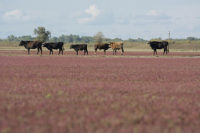Battling the bad intentions of food fraud
What protein processors can do to combat the latest challenge to a safe food supply — the concept of food fraud.

The problem with food fraud is, it can go beyond economics to harming public health.Furthermore, it’s a relatively new concept, for which the industry doesn’t have a handle on the scale of the problem yet. What researchers are discovering is that incidences of food fraud are frequent, and the opportunity for fraud is immense.
The National Provisioner spoke with Doug Moyer, researcher for Michigan State University’s (MSU) Anti-Counterfeiting and Product Protection Program (A-CAPPP), and John Spink, associate director of A-CAPPP, to give readers a great overview on food fraud.
NP: How prevalent a crime is food fraud for meat and poultry products? How does this compare to other food categories?
Moyer:It depends on whom you ask. There is data from two different sources. U.S. Pharmacopeiadid a study from 1980 to 2010 of journal articles and records, and found a total of 1,305 records regarding food ingredient adulteration. In that research, seven food ingredient categories recorded more than half of the recorded frauds. Meat and poultry doesn’t come up during that search of food ingredient adulteration. The National Center for Food Protection and Defense (NCFPD) though studied news and statistics from agencies from 1980 to 2011 looking for economically motivated adulteration events. They found only 137 events, but 24 of those events were fish and seafood, which lead 10 other food categories.
NP: How has food fraud evolved in recent years?
Moyer: Food defense emerged after the 9/11 attacks, as a threat to public health was recognized as deliberate actions from terrorists, sociopaths or even disgruntled employees. From that, the Department of Homeland Security sponsored a center of research for food defense through the University of Minnesota known as NCFPD. It conducts research and educates professionals regarding food risks beyond classic food safety. Food safety is accidental contaminations that cause a public health threat. So that’s where food defense emerged, because now we are looking for intentional acts.
The NCFPD sponsored research to define food fraud through a grant given to MSU’s A-CAPPP. Food fraud is certainly different than food safety because it’s intentional, but food fraud is different from food defense because [it involves] economic motivations and not for terrorist value or to intentionally do harm.
We’ve found the threats of food fraud can be direct, indirect and material. Direct means that the additive, ingredient or whatever fraud was perpetrated has an immediate toxic, if not lethal effect on people. Indirect food fraud is not immediate; it’s a long-term exposure. Maybe there is a toxic additive that accumulates over time and starts to give the consumer health-related issues, or just the reverse. If there is a beneficial ingredient that’s not put in to save money intentionally, that can cause a health risk to consumers over time. The last type of threat is material in nature. It doesn’t necessarily pose an immediate, or even long-term threat. It can be re-labeling products. It can be smuggling products to avoid tariffs and import regulations. It can be simply changing a label to say something other than what it is. Those probably are the hardest to detect, because they are not necessarily causing an illness to the public health.
NP: What are the challenges for meat and poultry processors in regard to food fraud? What can be done to close these gaps?
Moyer:We see two gaps. One is globalization and another one is limited perspectives. Globalization is the expanding economic inter-connectivity that both corporations and consumers have continued to embrace. What this really means is that global supply chains represent great opportunities as well as risks, in particular, for food ingredients. If there is a food manufacturer in the United States who goes offshore to buy a particular component — maybe a chemical preservative — it’s that length in supply chain from their global relationships that introduces additional risks.
Regarding limited perspectives, scientists and professionals are in their own chimneys, and they don’t intuitively understand the various aspects of food fraud or food defense. For example, food scientists don’t think like criminals, and they don’t think like terrorists, so you really can’t expect a food scientist to understand completely and offer solutions. What we teach at MSU’s A-CAPPP is a multidisciplinary approach for food that includes at least food science, supply chain management, packaging science and crime science. We emphasize classic crime prevention as the foundation to first understanding fraud and the perpetrators. Rather than slapping a bar code or an RFID tag on a package and hoping it works, we’ve got to understand what the vulnerabilities are. Who are the people who are trying to exploit you? Do they even care about RFID? You can protect your authentic supply chain, but we should all be worried about the non-authentic supply chain.
Spink:A key in reducing the fraud opportunity also includes public and private partnerships. Industry is working together through groups, such as the Grocery Manufacturers Association and the Global Food Safety Initiative. Agencies are engaged in the process through groups like U.S. Pharmacopeiaor conferences and an interdisciplinary group of academics is trying to get more involved. There really needs to be a holistic, all-encompassing strategy.
NP: How do you expect food fraud to evolve during the next few years?
Moyer:We expect that food fraud will emerge as a distinct discipline from food defense and from food safety. This is already being demonstrated through those public and private partnerships. We also expect industry to embrace prevention by proactively moving toward self-assessments and actions rather than reacting to instances or waiting for governmental guidance regarding impending regulations. We’re clearly pointing right at the Food Safety and Modernization Act. It’s a law with no governmental guidance yet issued to industry about how we’re going to get this done, and frankly, people in the food industry cannot wait and consumers cannot wait to be protected.
Spink: The vulnerabilities are getting clearer. These are not countermeasures to meet some regulation, but improve business work processes and protect shareholder values.
Looking for a reprint of this article?
From high-res PDFs to custom plaques, order your copy today!








